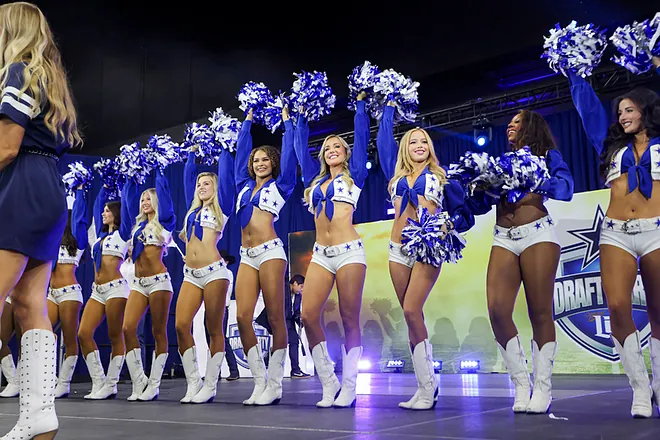The Dallas Cowboys Cheerleaders are entering a new era in 2025—one defined by long‑overdue respect and compensation that finally aligns with the millions their franchise generates. After years of near‑minimum wage pay and public outcry, the team has secured a life‑changing, roughly 400% salary increase, putting cheerleaders on a much more sustainable financial footing. To fully appreciate the transformation, it is necessary to revisit the journey that led to this breaking point in pay equity.
For decades the cheerleaders were seen as glamorous sideline embellishment, cheerfully underpaid and largely invisible in the business ledger of the NFL’s most valuable team. Audiences saw choreographed dances and sparkling smiles on game days, but few saw the reality beneath the surface: the team members worked 30 to 40 hours per week—practicing routines, attending rehearsals, traveling to public appearances and filming documentaries—while earning wages comparable to fast‑food employees. As one squad alum put it during the recent Netflix series, they made “like a substitute teacher” or “a Chick‑fil‑A worker that works full‑time” en.wikipedia.org+14thedailybeast.com+14fox4news.com+14.
A watershed moment came in Season 1 of Netflix’s docuseries America’s Sweethearts: Dallas Cowboys Cheerleaders, which premiered in 2024. The show ripped away the façade, spotlighting not only the cheerleaders’ athletic rigor and emotional investment but also the harsh squeeze of low wages. Viewers watched veteran members balance multiple jobs alongside rehearsals, vacation past their means, and push through grueling schedules. One cheerleader, Jada McLean, described clocking hours at around $15 per hour plus about $500 per game, yet still struggling to cover basic living costs fox4news.com+8thedailybeast.com+8washingtonpost.com+8. Another, Kat Puryear, compared their modest earnings to a “Chick‑Fil‑A worker.”
Public reaction was swift and fierce. Fans, commentators and even sponsors began questioning why the cheerleaders—the face of the franchise in many promotional endeavors—were effectively subsidizing the Cowboys’ brand visibility. The contrast between NFL players earning millions and cheerleaders scraping by became a hot‑button issue. The second season of the docuseries, which premiered on Netflix on June 18, 2025, pivoted to another revealed truth: the squad’s empowerment. Veteran members like Megan McElaney, Armani Latimer and Jada McLean refused to let their performances be reduced to eye candy; they became media advocates for pay justice, demanding recognition for the labor that fueled the franchise’s $10 billion-plus valuation thedailybeast.com+1eonline.com+1washingtonpost.com+1abcnews.go.com+1.
As cameras followed their grueling 2024–25 season, the squad staged negotiations—not quietly behind closed doors but in public view. The tension was palpable when some teammates feared repercussions if they joined the call for change. Illuminating group Zoom meetings even revealed cracks within the squad, with some members accusing colleagues of leaking plans to leadership—highlighting courage amid vulnerability . Coaches and directors, inflammatory to some, reminded the squad that cheerleading is a privilege. They argued that despite their low compensation, the reward lay in the experience, prestige and lifelong bonds the role provided. Yet veterans refused to accept heartfelt words without just compensation.
The turning point came toward the end of the NFL season and was revealed in the second season finale. It was announced that the entire squad had won their stand: beginning in the 2025–26 season, every cheerleader would receive a roughly quadruple pay raise the-sun.comdecider.com+1eonline.com+1. The cheered response off‑camera was matched by cheering across social media. On X (formerly Twitter), supporters were quick to call the raise “long overdue” and insisted that veterans deserved even more than the reported $75 per hour eonline.com+3thedailybeast.com+3fox9.com+3.
But how does this raise translate into actual dollars?
Before 2019, the copious hours for a Cowboys cheerleader—covering rehearsals, community outreach, promotional work, and more—went largely uncompensated or paid at minimum wage. A 2018 lawsuit by alum Erica Wilkins claimed she earned less than the team’s mascot, worked unpaid overtime, and was paid under the federal minimum wage; the case settled in 2019, resulting in a small wage bump from $8 to $12 per hour and raising gameday pay from $200 to $400 decider.com+12washingtonpost.com+12elle.com+12. But the base wage remained below $15 per hour. Set against the hundreds of dollars the team paid out each week, that raise was still paltry.
Then came the docuseries. People magazine reported that cheerleaders averaged a disheartening $500 per game and $15–$20 per hour—including some working over 30 hours weekly—and yet still averaging an annual income near $75,000, largely because of supplemental employment thedailybeast.com+4people.com+4elle.com+4. That meant cheerleaders invested roughly 600–1,000 hours a season just for the Cowboys. As one pointed out, even a $15‑an‑hour wage across that span equated to just $9,000–$15,000 in primary income.
So what does a 400% raise mean? Given the commonly referenced game‑day rate of $500 in 2024, a quadrupling brings that to $2,000 per game. Over a 17‑game regular NFL season, that’s $34,000 in game pay alone elle.com. Add in rehearsal and appearance pay, now elevated to about $75 per hour for veterans, and the annual figure climbs significantly. Before 2025, cheerleaders were secondary earners working multiple jobs; now full‑time squad veterans can potentially make over $75,000 annually just from cheerleading. If they hold leadership roles, that income could be higher, indicating that this isn’t just a raise, but a shift toward career viability.
Within the series, veteran Megan McElaney described the raise simply as “life‑changing.” The sentiment was echoed by Jada McLean, who said she felt “relief” knowing their efforts had borne fruit and “we were done fighting” decider.com+9abcnews.go.com+9wlbt.com+9. Veteran Armani Latimer added that even though she may not personally benefit if she retires, she is proud to leave a legacy for future cheerleaders—one rooted in dignity and compensation for labor washingtonpost.com+3decider.com+3eonline.com+3.
Public discourse has been overwhelmingly supportive. Social media users emphasized that cheerleaders are core to the Cowboys’ brand identity and engage in far more than a sideline performance—they are public ambassadors in appearances, commercials, charity events, and global USO tours . Many commentators observed that cheerleaders fulfill a labor‑intensive role that entails physical strain, wear and tear on their bodies, and no benefits such as health insurance, even as the Cowboys profited with a $10.1 billion valuation people.com+3apnews.com+3the-sun.com+3. In that context, the raise was both vindication and illumination—the public finally saw what was hidden behind sparkling uniforms.
This 400% raise could set a precedent across the NFL. Historically, franchise cheerleaders have been poorly compensated, often working part-time while earning full-time schedules. The Cowboys—longest‑running and most prominent—may now force rival teams to reassess their own pay structures. While cheer-leading remains a part-time title, the depth of commitment required now justifies more serious employer obligations, in pay and benefits.
Industry analysts say the implications are broader: when high-profile brands like the Cowboys acknowledge the economic value of roles previously dismissed as peripheral, the entire labor market absorbs a new definition of worth. Whether in entertainment, hospitality, or sport, organizations must now confront the gap between brand visibility and wage labor. If the cheerleaders of America’s Team can secure livable pay, others may follow.
That openness also discredits decades of paternalistic messaging—that cheerleaders participate for love, sisterhood, or prestige. It’s not that passion is invalid; but passion without remuneration is exploitation. As veterans noted, cheerleading had been framed as an elite experience—an opportunity—but one sold by masks that hid sleepless nights, second jobs, exhaustion, injuries, and financial stress. By demanding respect and equating their performance with comparable professional measures, they’ve asked society to reassess how privilege and labor interact washingtonpost.com+1timesofindia.indiatimes.com+1decider.com+10people.com+10fox9.com+10.
Looking ahead, many cheerleaders now plan beyond the sidelines. With compensation that enables savings, investment or further education, the role becomes a career, not a temporary stunt. Alumni are already reevaluating how they promote the role—not as aspirational but exploitative, altered by unions and schedule changes yet hopeful for equity.
Critics argue that salaries could—and should—go further. Many online voices pointed out that $75 per hour and $2,000 per game are still modest compared to NFL salaries, advertising contracts, and the broader entertainment industry. Some urged the Cowboys to include health insurance, paid leave and retirement contributions—benefits customary in jobs of this scale thedailybeast.com. Team execs have said the squad is still “part‑time” employees with healthcare access to team doctors but no formal insurance plan bleacherreport.com. As a result, one of the next steps on public radar is negotiating benefits, not just dollars—a continuation of a movement newly emboldened.
In the seasons ahead, the sequel will likely follow: a behind‑the‑scenes re‑negotiation of benefits, roles, schedules and security. Will teams finally view cheerleaders as employees deserving of the full architecture of labor rights? Or will pay rises become a cap on goodwill, without meaningful protections? The Cowboys have taken the first step; whether the rest follow remains to be seen.
One thing is clear: after a 400% raise, it’s no longer plausible to frame Dallas Cowboys cheerleading as glamorous charity. It’s a profession—dynamic, demanding and deserving—not optional entertainment. The franchise spotlight is no longer solely on the gridiron; now it shines on the sidelines, on women who dared to ask, “What are we really worth?”



